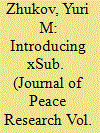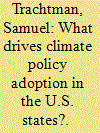|
|
|
Sort Order |
|
|
|
Items / Page
|
|
|
|
|
|
|
| Srl | Item |
| 1 |
ID:
167285


|
|
|
|
|
| Summary/Abstract |
Researchers today have access to an unprecedented amount of geo-referenced, disaggregated data on political conflict. Because these new data sources use disparate event typologies and units of analysis, findings are rarely comparable across studies. As a result, we are unable to answer basic questions like ‘what does conflict A tell us about conflict B?’ This article introduces xSub – a ‘database of databases’ for disaggregated research on political conflict (www.x-sub.org). xSub reduces barriers to comparative subnational research, by empowering researchers to quickly construct custom, analysis-ready datasets. xSub currently features subnational data on conflict in 156 countries, from 21 sources, including large data collections and data from individual scholars. To facilitate comparisons across countries and sources, xSub organizes these data into consistent event categories, actors, spatial units (country, province, district, grid cell, electoral constituency), and time units (year, month, week, and day). This article introduces xSub and illustrates its potential, by investigating the impact of repression on dissent across thousands of subnational datasets.
|
|
|
|
|
|
|
|
|
|
|
|
|
|
|
|
| 2 |
ID:
144087


|
|
|
|
|
| Summary/Abstract |
If a government is facing an armed uprising, why doesn’t it confiscate all privately owned weapons? When and where is forcible disarmament most likely to occur? Can forcible disarmament reduce rebel activity? To establish a monopoly on the use of force, a government must either convince its citizens not to rebel, or remove their capacity to do so. Existing literature has left this choice – between punishment and disarmament – virtually unexplained. Most existing research focuses on disarmament in the context of post-conflict stabilization, rather than forcible disarmament during war. I introduce a mathematical model of irregular warfare, in which government and rebel forces seek a monopoly on violence. The model shows that disarmament occurs mainly in ‘hard cases’, where otherwise strong governments are unable to punish opponents or reward supporters. I test these claims with declassified archival data on counterinsurgency in the Soviet North Caucasus. The data confirm that disarmament was most likely where the government’s coercive leverage was limited – due to poor intelligence and potential backlash from collateral damage. In these otherwise challenging circumstances, disarmament significantly reduced rebel violence – short-term and long-term, locally and region-wide. By limiting the potential coercive resources under the opposition’s control, disarmament can render rebels unable to sustain a campaign of violence against the state.
|
|
|
|
|
|
|
|
|
|
|
|
|
|
|
|
| 3 |
ID:
171492


|
|
|
|
|
| Summary/Abstract |
Climate advocates increasingly view state policy as a crucial tool to reduce greenhouse gas emissions in the U.S. However, the literature lacks systematic empirical analysis of which, when, and why states adopt policies mitigating climate change. While traditional climate federalism highlights the co-benefits to climate policies in driving subnational policy decisions, more recent work emphasizes the powerful role of partisan control of office. I collect and analyze panel data measuring the strength of state policy from 2007 to 2014 in four areas: renewable portfolio standards, distributed generation, energy efficiency, and severance taxes on oil and gas extraction. While renewable portfolio standards and distributed generation policies were driven primarily by Democratic partisanship in state electorates, energy efficiency policies were less responsive to Democratic partisanship but marginally responsive to unified Democratic control of state government. Finally, these political factors did not measurably influence state severance taxes.
|
|
|
|
|
|
|
|
|
|
|
|
|
|
|
|
|
|
|
|
|